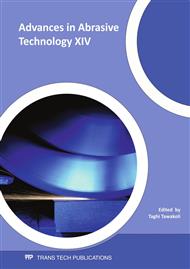p.482
p.489
p.495
p.502
p.508
p.517
p.523
p.530
p.536
A Novel Desktop Device for Lapping Milled Micro Thin-Walled Structures
Abstract:
Current requirements for producing highly precise and ultra-smooth micro structured surfaces of small parts are proposed in certain situations. The following question arises: how to make a highly precise and ultra-smooth micro-structured surface with high efficiency and low cost Novel desktop lapping and polishing devices should be developed to satisfy these requirements. In order to improve the surface topography and remove the surface damaged layer of a highly precise and ultra-smooth micro thin-walled structure after milling with the width of 150 μm and the depth of 10 μm, a novel lapping desktop device is designed and developed. There are two key points in the design of the lapping desktop device: one is the vertical coupled macro-micro movement axis; the other is the fixture with a thin and flexible hinge structure, which has the capability of measuring both force and displacement as a double-feedback sensor to control both the micro lapping force and the depth of lapping. The experimental results show that the surface topography of the micro thin-walled structured surface is much improved after lapping, and that the three-dimensional surface roughness decreased from 329 nm to 82.2 nm.
Info:
Periodical:
Pages:
508-513
Citation:
Online since:
August 2011
Authors:
Price:
Сopyright:
© 2011 Trans Tech Publications Ltd. All Rights Reserved
Share:
Citation:


